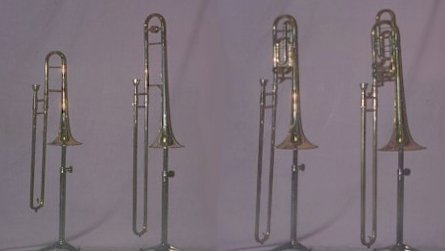The trombone comes in many varieties, the most well known being the tenor slide trombone. The trombone is in actuality a family of instruments ranging from the contrabass all the way up to the soprano. It includes the more common slide trombones (and best, in my opinion), valve trombones, and even a hybrid version with a slide and valves known as the "Superbone".
The trombone is certainly the most recognizable wind instrument, being the only one with a true slide section. The trombone has been in existence for centuries under various forms and names, but has remained relatively unchanged for a majority of that time. Trombone, as it is called today in English, French, and Italian speaking countries, is simply the Italian Tromba(trumpet) with the suffix one, meaning 'big trumpet'. This simple and widely accepted name has not always been the accepted term, and has seen much evolution in various languages.
One familiar name to most trombone players for the instrument is the English Sackbut. Francis W. Galpin1, who spent a great deal of time studying the etymology of the word, suggests that it is probably derived from the Spanish Sacabuche literally meaning 'draw-pipe'. Sacabuche is seen as early as the 14th century. Curt Sachs2 preferred an Old French derivation, Saqueboute, from saquier(to pull) and boter(to push). This term was also used in the 14th century for a large boat-hook used to unhorse cavalry in battle. However, by the end of the century the term Saquebute was in use as the term for the musical instrument. Other spellings found in early records are saykebud, shakebutte, and shagbolt, none of which were found in English literature, suggest that it was still an unfamiliar instrument in England. In fact, the instrument first appeared in England in the 15th century, at which time foreign players were used. In 1501, we have recorded the definite English Sackbut under King Henry VII. It is best to say that the etymology of this word is still not certain.
The current German term for the instrument, Posaune, also has an interesting history. The trombone itself descended from a long straight trumpet called the Buisine, and as the instrument transformed so did the name. The Middle High German equivalent of Buisine was Buzine. Over time the word became Busune in the Middle Ages, then Buzaun, and finally Posaune after the 16th century.
Leaving the history of the names for the trombone, let's consider the development of the instrument itself. Most scholars will agree today that the trombone most likely descended from a long straight trumpet.
The modern trombone is not really all that different from its medieval ancestors. It still has the distinct s-shape. The proportions of the instrument are somewhat different however. The modern trombone comes in various sizes, but in general is larger in bore than its predecessors. Its characteristics are a cylindrical bore, meaning that the diameter of the tubing stays relatively the same throughout the length of the horn, a handslide, and a bell section that extends out proportionately about 1/3 of the length of the slide when assembled. The bell section is different than that of the early trombone. The flare is now more sudden and closer to the end of the bell section, rather than being funnel-like.
There are several different types of trombones in use in today's ensembles. The trombone is an integral part of the modern orchestra, wind symphony, jazz ensemble, and brass band. The three types of trombones most often used are the alto trombone, tenor trombone, and bass trombone. Of these three, the most common is the tenor trombone. The tenor and bass trombones are typically in the key of Bb. The alto, more rarely used, is typically in the key of Eb, or sometimes F. The alto, by its name, is the highest pitched trombone. There is also a higher soprano trombone, which in reality is a slide trumpet. These are rarely seen and if ever used are typically played by a trumpet player due to the size of the mouthpiece. The tenor is the middle pitched trombone. Its range is often extended lower by an attachment of extra tubing which is used by activating some type of valve. These attacthments usually pitch the trombone in the key of F. They are often referred to as an F trigger attachment, ot just F-attachment. The bass trombone is the low instrument of the family. It is still in the key of Bb like the tenor, but has a much larger bore size. It also often has two trigger attachments if different keys, usually F and another key, extending its range even lower. There is also a lower contrabass trombone which is rarely used but is a very interesting trombone.
Here are some photographs of some typical modern trombones.

From left to right: Alto trombone in Eb, small-bore Tenor trombone in Bb, large-bore Tenor trombone in Bb with F trigger attachment, Bass trombone in Bb with F and G trigger attachments. The Alto is a Jean Courtois, the small-bore Tenor is a King 2B, the large-bore Tenor is a Bach 42B, and the Bass is a Bach 50B30. Notice the difference in sizes. You can bset compare bore size by looking at the bells. Notice how much smaller the King 2B's bell is than the Bach 42B's. Then compare the Bach 42B bell to the Bach 50 bass trombone bell.
More to come...Now for a lighter work on trombone history...read Kevin Thompson's story.
1. F. W. Galpin, "The Sackbut, its Evolution and History", Proceedings of the Musical Association, London, 1906.
2. Curt Sachs, The History of Musical Instruments, London, J.M. Dent and Sons Ltd., 1942.
Send comments to Brian Nuckels, bnuckels@oocities.com.